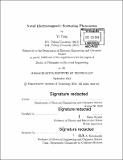| dc.contributor.advisor | Marin Soljac̆ić. | en_US |
| dc.contributor.author | Yang, Yi,Ph. D.Massachusetts Institute of Technology. | en_US |
| dc.contributor.other | Massachusetts Institute of Technology. Department of Electrical Engineering and Computer Science. | en_US |
| dc.date.accessioned | 2020-03-09T18:53:20Z | |
| dc.date.available | 2020-03-09T18:53:20Z | |
| dc.date.copyright | 2019 | en_US |
| dc.date.issued | 2019 | en_US |
| dc.identifier.uri | https://hdl.handle.net/1721.1/124096 | |
| dc.description | Thesis: Ph. D., Massachusetts Institute of Technology, Department of Electrical Engineering and Computer Science, 2019 | en_US |
| dc.description | Cataloged from PDF version of thesis. | en_US |
| dc.description | Includes bibliographical references (pages 141-161). | en_US |
| dc.description.abstract | Scattering of electromagnetic waves is fundamentally related to the inhomogeneity of a system. This thesis focuses on several theoretical and experimental findings of electromagnetic scattering under contemporary context. These results vary from scattering off real structures and off synthetic gauge fields. The source of scattering also varies from near-field to far-field excitations. First, we present a general framework for nanoscale electromagnetism with experimental verifications based on far-field plasmonic scattering. We also theoretically propose two schemes featured by thin metallic films and hybrid plasmonic dielectric nanoresonantors, respectively, aiming at achieving high radiative efficiency in plasmonics. Second, treating free electrons as a near-field scattering excitation, we derive a universal upper limit to the spontaneous free electron radiation and energy loss, verified by measurements on the Smith-Purcell radiation. Such an upper limit allows us to identify a new regime of radiation operation where slow electrons are more efficient than fast ones. The limit also exhibits a emission probability divergence, which we show can be physically approached -by coupling free electrons to photonic bound states in the continuum. Finally, we will discuss the scattering of optical waves off synthetic magnetic fields. Specifically, we will describe a synthesis non-Abelian (non-commutative) gauge fields in real space, enabled time-reversal symmetry breaking with distinct manners. These synthetic non-Abelian gauge fields enables us to observe the non-Abelian Aharonov-Bohm effect with classical waves and classical fluxes, relevant for classical and quantum topological phenomena. | en_US |
| dc.description.statementofresponsibility | by Yi Yang. | en_US |
| dc.format.extent | 161 pages | en_US |
| dc.language.iso | eng | en_US |
| dc.publisher | Massachusetts Institute of Technology | en_US |
| dc.rights | MIT theses are protected by copyright. They may be viewed, downloaded, or printed from this source but further reproduction or distribution in any format is prohibited without written permission. | en_US |
| dc.rights.uri | http://dspace.mit.edu/handle/1721.1/7582 | en_US |
| dc.subject | Electrical Engineering and Computer Science. | en_US |
| dc.title | Novel electromagnetic scattering phenomena | en_US |
| dc.type | Thesis | en_US |
| dc.description.degree | Ph. D. | en_US |
| dc.contributor.department | Massachusetts Institute of Technology. Department of Electrical Engineering and Computer Science | en_US |
| dc.identifier.oclc | 1142634086 | en_US |
| dc.description.collection | Ph.D. Massachusetts Institute of Technology, Department of Electrical Engineering and Computer Science | en_US |
| dspace.imported | 2020-03-09T18:53:19Z | en_US |
| mit.thesis.degree | Doctoral | en_US |
| mit.thesis.department | EECS | en_US |
